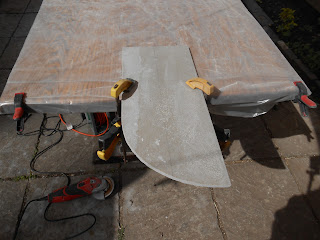 |
| DIY Self- Build Kitchen Floor Concrete Cupboards |
This post is about my DIY building of a concrete and brick kitchen base cupboard unit. It includes links to Amazon products that might earn me a commission. I have either used these products in this project or they are the products I would recommend for it.
HERE is the short video of me building this build of a 3m long conrete, brick and tile floor cupboard unit in my kitchen. The longer version of this video can be found HERE.
Building a base unit out of blocks was appealing to me having already built one when living in Spain and realising how solid and long-lasting they are. I rarely saw flat-pack type kitchens abroad and had grown to view them as over-priced and unnecessary. If only more people realised how easy it is to build your own base units!
I had no idea what I was going to do because I had no guide or tutorial to follow. Yes, I had seen pictures of brick-built base units and seen a few videos of people building base units out of bricks and cement, and had built my own, but I had different materials to work with so had to devise a new method. In Spain, I'd built my base unit out of terracota roofing tiles and a bonding/plastering material called Yeso. However, I couldn't find these two materials in the UK, so decided to build with aerated concrete blocks, bricks, leftover porcelain floor tiles and ceramic tiles.
 |
| DIY Concrete Block Kitchen Base Unit |
After lots of measuring and worrying, I decided the best starting point was to get my freebie over positioned properly and build out from there. I needed to leave a small gap on either side of the oven, so taped some batons to the sides.
 |
| DIY Concrete Block Kitchen Base Unit |
I then built two aerated concrete block walls either side of the other, pushed up against the batons. I then built the rest of the walls.
I used Hard As Nails contact adhesive to stick the blocks together. It was a good product and worked well. I much prefer to use the white adhesive rather than the beige products - the latter tending to dry far too quickly and form a skin that means it completely loses it's stickiness.
 |
| DIY Concrete Block & Brick Kitchen Unit |
Then, I needed to build the raised bottom and did this by packing in bricks (these were given to me). I just set them in place with Blue Circle wet ready mix mortar, but I could have used 'Hard As Nails'.
 |
| DIY Concrete & Brick Kitchen Cupboards |
I clad the bricks with leftover porcelain floor tiles, having made sure the bricks were positioned so grout lines were supported. I also clad the skirting with porcelain tiles and built the skirting in a nice smooth form to make sweeping and mopping easier.
 |
| Diamond Blade Tile Cutting Machine |
I cut the tiles with a diamond tile cutter (easier than you might think). For the curved end, I cut the small tile pieces at an angle to help them fit together better. You can change the tilt of the machine's work surface.
 |
| Cutting a curve in tile with angle grinder |
The curved edge of the tile that sat on top of those tiny pieces was cut with an angle grinder using a diamond blade. Again, this is easier than you might think. I did this very entrepidly as I had never done it before, but now I have no fear of such tasks. I slowly marked along the pen line over and over. Diamond blades are excellent and seem to last forever. I've had the same one for six years and it still cuts through hard material, such as marble, with no trouble.
 |
| DIY Kitchen |
The next job was to clad the concrete block walls with ceramic tiles. These were very cheap tiles I picked up from the clearance section of Walls and Floors. I used plastic tile spacers, mostly to stop them slipping down.
 |
| Tile Cutter |
I cut the ceramic tiles using a hand powered tile cutter. You just score the tile once lightly with the cutter and then snap it with the lever.
 |
| Salvaged worktop |
After that, I fitted the shelves inside the cupboards. For this, I used some solid beech worktop I was given - it was about to be thrown away at the tip! Be brave and run up to people shouting, "Don't throw it away!!!" I fitted the shelves with small angle brackets and adhesive.
 |
| DIY Kitchen Cupboards |
I then fitted lengths of oak right along the two sides of the oven to connect the tops of the walls, plus ran some wood back to the back wall. This is what the worktop rested on.
 |
| DIY Kitchen Base Unit |
The fronts of the concrete block walls were also clad but in oak stripwood from Love Skirting. Everything was sealed around the edges with oak coloured silicone and the oak was varnished. The oak baton that ran above the oven was first drilled with large air vent holes.
You might be wondering why I used aerated concrete blocks and not the heavier blocks. I always try to use the smallest or lightest material needed for the job. In other projects, you've probably seen me using thinner wood or board than most people use. I don't agree that it's better to go big and strong 'to be sure', but to use just the right size and strength. This not only saves money but also saves on heavy lifting and a bulky end result.
I was extremely lucky that this project worked out well as many things could have gone wrong and it could have been a disaster. Thankfully, it all went went and I am very pleased with the end result. I just have to make some curtains to go into the larger cupboards to finish this job off.
Let me know what you think to it and reach out if you need any advice on your own self-build kitchen cupboard project.









































